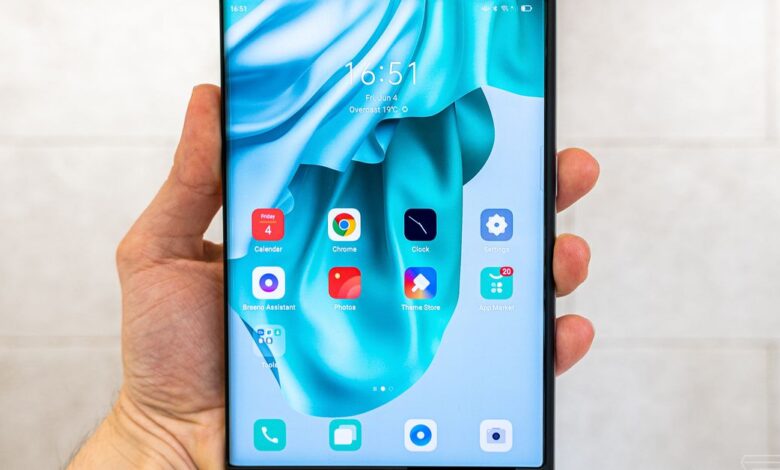Oppo’s rollable concept phone is pure potential lacking polish

Two hundred thousand. That’s the magic number of times Oppo wants its rollable X 2021 concept phone to be able to expand and contract before it’ll consider it durable enough to turn into a commercial device. That’s 200,000 times the device will need to be able to transform from a 6.7-inch phone into a 7.4-inch mini tablet, and 200,000 times it’ll need to successfully contract back.
But as it stands, Oppo says the Oppo X 2021 is durable enough to manage just half that, at 100,000 cycles. In theory, that’s already enough for around five and a half years of use if you open and close it 50 times a day, but as we’ve seen with early foldable devices, these figures sometimes don’t translate into the real world. The number shows the scale of the work Oppo still has to do on its concept, which it unveiled last November during its second annual “Inno Day” celebration.
In durability terms, Oppo thinks it’s halfway toward turning its rollable phone from a concept into reality. But after having spent an afternoon using the company’s prototype device for myself, it’s clear that hitting this arbitrary number is far from the only challenge Oppo is facing in bringing this device to market.
At first glance, the Oppo X 2021 looks like a regular 6.7-inch smartphone, designed to do everything you’d expect a regular smartphone to be able to do. But at the tap of a button, the phone starts to whir and unroll its display to 7.4 inches in size, bringing it closer to the form factor of a small tablet. Similar concepts have been announced by competitors ranging from LG (prior to its announcement that it’s quitting the smartphone industry) to TCL, but this is the first such functional device we’ve actually been able to try out for ourselves.
It’s a cool magic trick, so naturally there’s a series of complicated mechanisms working behind the scenes to make it all possible. That whirring sound is coming from a pair of motors inside the X 2021, which are expanding the phone’s dynamic frame into its full size. Meanwhile, the screen itself is rolling around the left hand side of the phone, curving around a 6.8mm axis that Oppo says allows the screen to unroll with “virtually no trace.” Behind this screen are a series of metal slats, which slot together to support the screen regardless of whether it’s expanded or contracted.
There’s a lot going on inside the phone, which puts the overall device on the heavier, bulkier side. Held next to my own iPhone 12 Pro, the Oppo X 2021 is thicker at 10.7mm compared to 7.4mm, and heavier at 278g (compared to 189g). That’s a substantial difference, but it’s in a similar ballpark to existing plus-sized devices on the market.
A transformation from 6.7 inches to 7.4 inches might not sound like too big a change, but it’s much larger when you consider the phone’s aspect ratio is also changing. You start with a roughly 19.85:9 widescreen display (with a resolution of 1175 x 2592) and end with a screen that’s got an aspect ratio closer to 4:3 (or 4.36:3 to be exact, 1785 x 2592). Effectively, it turns into a device that’s just a tad smaller than a 7.9-inch iPad Mini. It might not be enough to turn it into a productivity powerhouse, but it’s enough to make watching films, gaming, reading, or looking up a map a less cramped experience.
On the face of it, it’s a similar promise to the one the likes of Samsung and Huawei have made with their foldable phones, wrapped up in an even more unproven form factor. But Oppo’s approach has a number of theoretical benefits.
For starters, Oppo’s rollable design means the telltale crease that has sat along the middle of every foldable released so far is all but absent from the X 2021. Look closely and you’ll spot a slight rumple on the left hand side of the screen, but it’s barely visible, even when the phone is showing a mainly black image. We’ve long held that the creases found on foldable devices like the Galaxy Z Fold 2 aren’t nearly as much of a problem once you’re actually using the device, but that’s not much consolation when you’re spending over $1,000.
:no_upscale()/cdn.vox-cdn.com/uploads/chorus_asset/file/22657752/akrales_20210604_4621_0012.jpg)
:no_upscale()/cdn.vox-cdn.com/uploads/chorus_asset/file/22657749/akrales_20210604_4621_0009.jpg)
The X 2021’s minimal crease is thanks to the fact the screen doesn’t need to bend anywhere near as sharply as it rolls round the edge of the phone. Oppo says the screen’s bend radius is 6.8mm, a comparatively gentle curve. The Oppo X 2021 currently uses a plastic display, but this radius leaves the door open for the company to use folding glass in future iterations (one manufacturer, Schott, says its glass can be bent at a radius of under 5mm). However, Oppo would not reveal any firm plans to use folding glass in future models.
There’s also the fact that a rollable design gives you access to a lot more potential screen sizes than a folding one. Its maximum and minimum sizes will always be the same, but there’s no reason it couldn’t stop expanding at the 7.2, 7, or 6.8-inch mark. Similar to LG’s rollable TV, the phone could theoretically adapt to different aspect ratios, rather than leaving you with unsightly black bars while you’re playing a game or watching a film at a specific aspect ratio. But none of this functionality was available on the prototype I used.
That’s not to say that a rollable design doesn’t come with its own tradeoffs. The most obvious of these is that unlike a foldable, which lets you open up its display as quickly as a book, Oppo’s device takes the better part of two or three seconds to fully extend. It felt slow enough that you might not bother if you were in a hurry to check map directions. The company admits its electric motors also introduce another potential point of failure, which would need to be solved ahead of a commercial release.
:no_upscale()/cdn.vox-cdn.com/uploads/chorus_asset/file/22657750/akrales_20210604_4621_0010.jpg)
:no_upscale()/cdn.vox-cdn.com/uploads/chorus_asset/file/22657753/akrales_20210604_4621_0013.jpg)
There’s also the question of what effect having these motors inside a phone will have on its battery life. During my demonstration (which, granted, involved repeatedly expanding and contracting the phone in a way you’d never do in normal usage), the X 2021 needed to be recharged more than once. It was a prototype, which wouldn’t have any of the battery optimizations of a consumer product, but it’s still unclear what effect these motors could have on the eventual device’s battery life in more normal use.
Beyond simple practical concerns like these, there are also questions about whether Android is equipped to deal with devices with changing display sizes. When we reviewed Samsung’s latest foldable, the Galaxy Z Fold 2, last September, we found that the company effectively had to build a completely new layer of software on top of Android to make its foldable device work.
Oppo has ambitious plans for the X 2021’s software. The prototype runs Oppo’s ColorOS fork of Android and is able to run dual apps side by side, or display two windows of the same app to make use of the extra screen real estate. But so far, most of these features are limited to Oppo’s own built-in apps, and it’s still working with third-party developers to get them to enable support.
:no_upscale()/cdn.vox-cdn.com/uploads/chorus_asset/file/22657751/akrales_20210604_4621_0011.jpg)
Oppo is making no attempt to hide the fact that its X 2021 concept is a work in progress. The device I used lacked many of the basic features you’d expect out of a modern smartphone. There was no biometric security, no selfie camera, and adjusting the device’s volume involved awkwardly tapping the side of the display in the absence of physical volume buttons. Even its flagship feature, the rolling, was a bit clumsy and unpredictable — you’re supposed to be able to expand and contract the phone with a simple swipe, but I could only reliably get it to work with a double tap.
But even as an in-development device, Oppo’s X 2021 represents one of the most advanced rollables we’ve seen. TCL may have announced a similar device, but at its last hands-on event its prototype was nonfunctional. Oppo’s prototype might be light on both hardware and software features, with an unproven level of durability, and a finicky transforming process. Ultimately, though, it fundamentally does the thing Oppo promised it’d do, and the company is happy to let press handle the device in a way that its competitors have yet to.
In an industry that’s dominated by increasingly anonymous black rectangles, it’s hard not to root for new form factors like the one Oppo is showing off with the X 2021. Now it needs to actually make it work.
Source link








